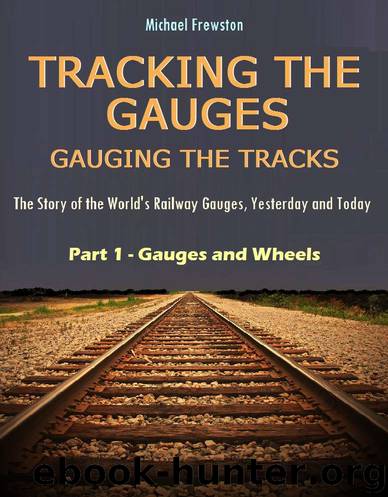Gauges and Wheels by Michael Frewston

Author:Michael Frewston [Frewston, Michael]
Language: eng
Format: epub
Publisher: Frewston Books Online
Published: 2012-01-01T05:00:00+00:00
By the spring of 1942, Hitler had converted many other lines in Russia to Standard gauge, including the important line to Kiev, in the Ukraine.
It was however the line from Brest to Moscow that was key to Hitler’s plan to capture Moscow, and hence Russia as a whole, in what is known as the Battle of Moscow. Hitler made good progress initially, completing the re-gauging of this line to 1435 mm through Minsk as far as Smolensk, reaching that city in 1942. His plan was to have a Standard gauge line to Moscow within weeks.
But Smolensk was only around two thirds of the 1000-km distance from Brest to Moscow, leaving over 350 km to go. With German troops already within 30 km of Moscow (and some divisions actually within sight of the city), it was not enough. The severe weather (one of the coldest winters ever recorded, which caused German locomotives to suffer major mechanical failures in the -40 °C cold), combined with various strategic blunders by Hitler, ensured that the unsupported German troops, short of both food and weaponry, were ultimately routed by Russian troops, who had been able to regroup. Moscow was thus saved from German occupation, and the course of Russian history (and possibly subsequent world history) was changed.
Once again, railway gauge incompatibility, and again between the Eastern European 1435 mm gauge and the Russian 1524 mm gauge, intervened in a European war, no doubt changing its outcome, and certainly preventing Hitler from keeping his troops both supplied and on the move, as he needed to, if he was going to capture Russia. Operation Barbarossa ultimately failed. One can only speculate how the world might be different today if this battle had succeeded.
[I should stress that this brief summary of Hitler’s program of converting Russian lines to Standard gauge, especially the changing gauge situation in the Baltic states just prior to and during the first three years of World War II, is somewhat of an over-simplification of what was a very complex series of events that happened over this period of time. I do cover this in a bit more detail in Part 4 dealing with ‘Area 1520’, but to go into this aspect much deeper would require a book of its own!]
I have already mentioned the American Civil War. That too was a war whose outcome was affected by railway gauge incompatibility. I will leave that story to the chapter in Part 7 dealing with the USA.
Download
This site does not store any files on its server. We only index and link to content provided by other sites. Please contact the content providers to delete copyright contents if any and email us, we'll remove relevant links or contents immediately.
| Automotive | Aviation |
| History | Mass Transit |
| Owner's Manuals & Maintenance Guides | Railroads |
| Reference | Ships |
Small Unmanned Fixed-wing Aircraft Design by Andrew J. Keane Andras Sobester James P. Scanlan & András Sóbester & James P. Scanlan(32743)
Navigation and Map Reading by K Andrew(5111)
Endurance: Shackleton's Incredible Voyage by Alfred Lansing(4676)
And the Band Played On by Randy Shilts(2127)
Wild Ride by Adam Lashinsky(1933)
The Box by Marc Levinson(1927)
Top 10 Prague (EYEWITNESS TOP 10 TRAVEL GUIDES) by DK(1926)
The Race for Hitler's X-Planes: Britain's 1945 Mission to Capture Secret Luftwaffe Technology by John Christopher(1817)
The One Percenter Encyclopedia by Bill Hayes(1787)
Trans-Siberian Railway by Lonely Planet(1699)
Girls Auto Clinic Glove Box Guide by Patrice Banks(1682)
Bligh by Rob Mundle(1653)
Looking for a Ship by John McPhee(1629)
Batavia's Graveyard by Mike Dash(1606)
Good with Words by Patrick Barry(1599)
TWA 800 by Jack Cashill(1592)
Fighting Hitler's Jets: The Extraordinary Story of the American Airmen Who Beat the Luftwaffe and Defeated Nazi Germany by Robert F. Dorr(1591)
Troubleshooting and Repair of Diesel Engines by Paul Dempsey(1556)
Ticket to Ride by Tom Chesshyre(1542)
